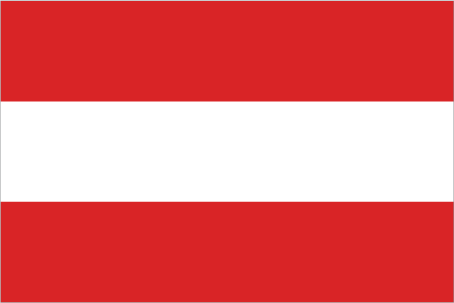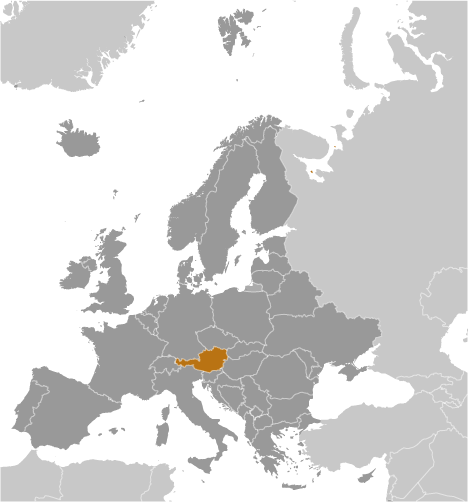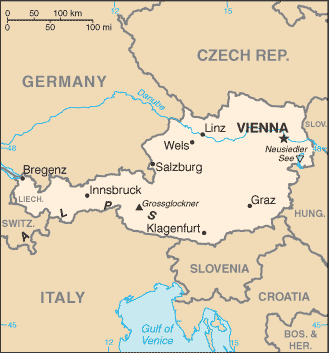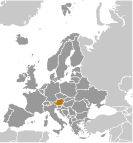
|
|
Advertisements:
EconomyEconomy - overview
Austria, with its well-developed market economy, skilled labor force, and high standard of living, is closely tied to other EU economies, especially Germany's. Its economy features a large service sector, a sound industrial sector, and a small, but highly developed agricultural sector. Following several years of solid foreign demand for Austrian exports and record employment growth, the international financial crisis of 2008 and subsequent global economic downturn led to a sharp but brief recession. Austrian GDP contracted 3.9% in 2009 but saw positive growth of about 2% in 2010 and 3% in 2011. Unemployment did not rise as steeply in Austria as elsewhere in Europe, partly because the government subsidized reduced working hour schemes to allow companies to retain employees. Stabilization measures, stimulus spending, and an income tax reform pushed the budget deficit to 4.7% in 2010 and 3.6% in 2011, from only about 1.3% in 2008. The international financial crisis of 2008 caused difficulties for Austria''s largest banks whose extensive operations in central, eastern, and southeastern Europe faced large losses. The government provided bank support - including in some instances, nationalization - to support aggregate demand and stabilize the banking system. Austria''s fiscal position compares favorably with other euro-zone countries, but it faces considerable external risks, such as Austrian banks'' continued high exposure to central and eastern Europe as well as political and economic uncertainties caused by the European sovereign debt crisis. In 2011 the government attempted to pass a constitutional amendment limiting public debt to 60% of GDP by 2020, but it was unable to obtain sufficient support in parliament and instead passed the measure as a simple law. In March 2012, the Austrian parliament approved an austerity budget that will bring public finances into balance by 2016. Gdp (purchasing power parity) World Ranking: 36
$356.5 billion (2011 est.)
$345.8 billion (2010 est.) $338 billion (2009 est.) Note Data are in 2011 US dollars Gdp (official exchange rate)
$419.2 billion (2011 est.)
Gdp - real growth rate World Ranking: 120
3.1% (2011 est.)
2.3% (2010 est.) -3.8% (2009 est.) Gdp - per capita (ppp) World Ranking: 18
$42,400 (2011 est.)
$41,200 (2010 est.) $40,400 (2009 est.) Note Data are in 2011 US dollars Gdp - composition by sector
Agriculture 1.5%
Industry 29.4% Services 69.1% (2011 est.) Labor force World Ranking: 95
3.668 million (2011 est.)
Labor force - by occupation
Agriculture 5.5%
Industry 27.5% Services 67% (2009 est.) Unemployment rate World Ranking: 39
4.2% (2011 est.)
4.4% (2010 est.) Population below poverty line
6% (2008)
Household income or consumption by percentage share
Lowest 10% 4%
Highest 10% 22% (2007) Distribution of family income - gini index World Ranking: 131
26 (2007)
31 (1995) Investment (gross fixed) World Ranking: 82
21% of GDP (2011 est.)
Budget
Revenues $202.6 billion
Expenditures $216.6 billion (2011 est.) Taxes and other revenues World Ranking: 24
48.3% of GDP (2011 est.)
Budget surplus (+) or deficit (-) World Ranking: 104
-3.3% of GDP (2011 est.)
Public debt World Ranking: 30
73.6% of GDP (2011 est.)
71.6% of GDP (2010 est.) Note This is general government gross debt, defined in the Maastricht Treaty as consolidated general government gross debt at nominal value, outstanding at the end of the year; it covers the following categories of government liabilities (as defined in ESA95): currency and deposits (AF.2), securities other than shares excluding financial derivatives (AF.3, excluding AF.34), and loans (AF.4); the general government sector comprises the sub-sectors of central government, state government, local government and social security funds; as a percentage of GDP, the GDP used as a denominator is the gross domestic product in current year prices Inflation rate (consumer prices) World Ranking: 82
3.5% (2011 est.)
1.7% (2010 est.) Commercial bank prime lending rate World Ranking: 179
3% (31 December 2011 est.)
2.564% (31 December 2010 est.) Stock of narrow money World Ranking: 19
$176.5 billion (31 December 2011 est.) $177.1 billion (31 December 2010 est.) Note See entry for the European Union for money supply for the entire euro area; the European Central Bank (ECB) controls monetary policy for the 17 members of the Economic and Monetary Union (EMU); individual members of the EMU do not control the quantity of money circulating within their own borders Stock of broad money World Ranking: 24
$411.9 billion (31 December 2011 est.) $401.8 billion (31 December 2010 est.) Stock of domestic credit World Ranking: 23
$639.7 billion (31 December 2011 est.) $526.9 billion (31 December 2010 est.) Market value of publicly traded shares World Ranking: 41
$82.37 billion (31 December 2011) $118 billion (31 December 2010) $107.2 billion (31 December 2009) Agriculture - products
Grains, potatoes, wine, fruit; dairy products, cattle, pigs, poultry; lumber Industries
Construction, machinery, vehicles and parts, food, metals, chemicals, lumber and wood processing, paper and paperboard, communications equipment, tourism Industrial production growth rate World Ranking: 35
7.5% (2011 est.)
Electricity - production World Ranking: 40
62.98 billion kWh (2009 est.)
Electricity - consumption World Ranking: 39
65.67 billion kWh (2009 est.)
Electricity - exports
18.76 billion kWh (2009 est.)
Electricity - imports
776 million kWh (2009 est.)
Oil - production World Ranking: 71
29,590 bbl/day (2010 est.)
Oil - consumption World Ranking: 48
277,900 bbl/day (2010 est.)
Oil - exports World Ranking: 80
46,020 bbl/day (2009 est.)
Oil - imports World Ranking: 38
282,200 bbl/day (2009 est.)
Oil - proved reserves World Ranking: 78
50 million bbl (1 January 2011 est.) Natural gas - production World Ranking: 58
1.716 billion cu m (2010 est.)
Natural gas - consumption World Ranking: 48
9.116 billion cu m (2010 est.)
Natural gas - exports World Ranking: 28
5.439 billion cu m (2010 est.)
Natural gas - imports World Ranking: 22
12.13 billion cu m (2010 est.)
Natural gas - proved reserves World Ranking: 77
16.14 billion cu m (1 January 2011 est.) Current account balance World Ranking: 29
$8.2 billion (2011 est.)
$11.46 billion (2010 est.) Exports World Ranking: 30
$173.6 billion (2011 est.)
$147.7 billion (2010 est.) Exports - commodities
Machinery and equipment, motor vehicles and parts, paper and paperboard, metal goods, chemicals, iron and steel, textiles, foodstuffs Exports - partners
Germany 32.2%, Italy 7.8%, Switzerland 4.4%, France 4.2% (2011) Imports World Ranking: 27
$183.3 billion (2011 est.)
$152 billion (2010 est.) Imports - commodities
Machinery and equipment, motor vehicles, chemicals, metal goods, oil and oil products; foodstuffs Imports - partners
Germany 42.8%, Italy 6.8%, Switzerland 5.6%, Netherlands 4.1% (2011) Reserves of foreign exchange and gold World Ranking: 54
$25.17 billion (31 December 2011 est.) $22.28 billionDebt - external World Ranking: 18
$883.5 billion (30 June 2011)
$755 billion (30 June 2010) Stock of direct foreign investment - at home World Ranking: 19
$281.4 billion (31 December 2011 est.) $273.3 billion (31 December 2010 est.) Stock of direct foreign investment - abroad World Ranking: 18
$284.1 billion (31 December 2011 est.) $274.9 billion (31 December 2010 est.) Exchange rates
Euros (EUR) per US dollar -
0.7194 (2011 est.) 0.755 (2010 est.) 0.7198 (2009 est.) 0.6827 (2008 est.) 0.7345 (2007 est.) Fiscal year
Calendar year
Comments
Add a new comment: |
Advertisement
Members area
Austria (Vienna):
 
GPS points from Austria (Vienna)
|
||||||||

 Once the center of power for the large Austro-Hungarian Empire, Austria was reduced to a small republic after its defeat in World War I. Following annexation by Nazi Germany in 1938 and subsequent occupation by the victorious Allies in 1945, Austria's status remained unclear for a decade. A State Treaty signed in 1955 ended the occupation, recognized Austria's independence, and forbade unification with Germany. A constitutional law that same year declared the country's "perpetual neutrality" as a condition for Soviet military withdrawal. The Soviet Union's collapse in 1991 and Austria's entry into the European Union in 1995 have altered the meaning of this neutrality. A prosperous, democratic country, Austria entered the EU Economic and Monetary Union in 1999.
Once the center of power for the large Austro-Hungarian Empire, Austria was reduced to a small republic after its defeat in World War I. Following annexation by Nazi Germany in 1938 and subsequent occupation by the victorious Allies in 1945, Austria's status remained unclear for a decade. A State Treaty signed in 1955 ended the occupation, recognized Austria's independence, and forbade unification with Germany. A constitutional law that same year declared the country's "perpetual neutrality" as a condition for Soviet military withdrawal. The Soviet Union's collapse in 1991 and Austria's entry into the European Union in 1995 have altered the meaning of this neutrality. A prosperous, democratic country, Austria entered the EU Economic and Monetary Union in 1999.